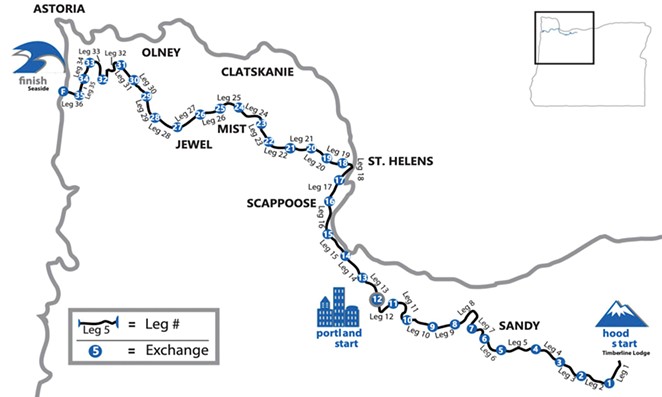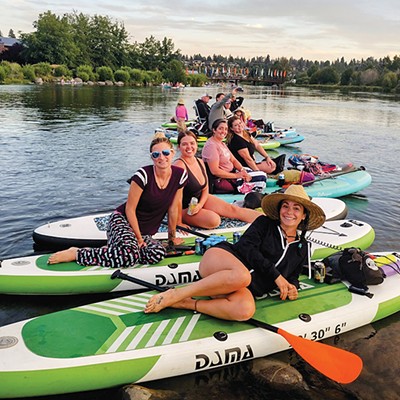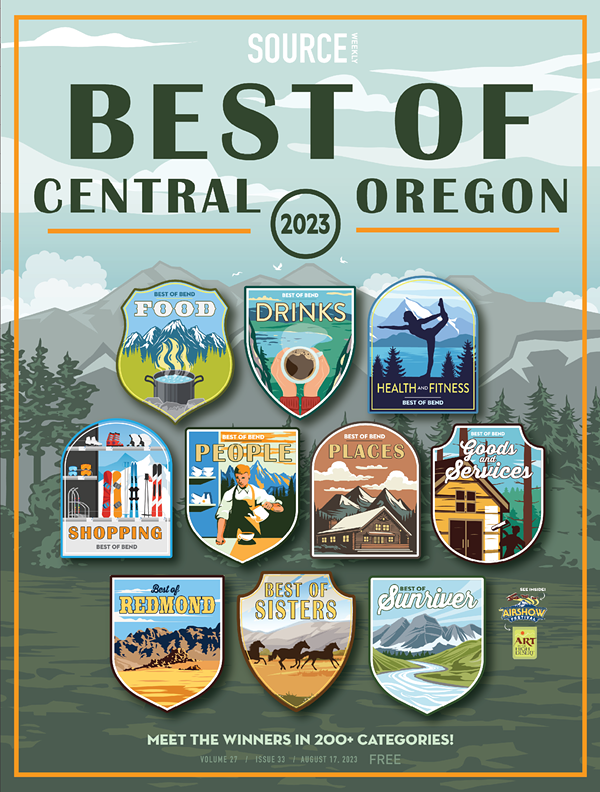For the last 41 years, runners have been teaming up to run 196 miles from Mt. Hood's Timberline Lodge to the Pacific Ocean for the Providence Hood To Coast Relay. Runners make their way through forested beauty, extreme descents, grueling hills, exposed flats, midnight runs, beach views and scenic gravel trails on the nearly 200-mile course. It's challenging yet rewarding. I know, because I just did it.

Teams consist of 12 runners split into two vans. Each runner is assigned to a set of legs — three runs totaling 14-18 miles. Van 1 transports runners 1-6, and van 2 transports runners 7-12. With five in a van and one out on the trail, there's enough room to rest up between legs.
The Providence Hood to Coast Relay has a limit of 1,000 teams per year, totaling around 12,000 runners. The relay draws in participants from over 40 countries and all 50 states, according to the Hood to Coast website. Getting on a Hood to Coast team can be difficult. For the last 24 years, the event has sold out on lottery opening day.
To get on a team, you must be thinking a year in advance or be down to join a team super last minute. The lottery is drawn 10 months before race day. Captains must apply for a team and be drawn. If not, racers can find open spots on Facebook, Instagram or through friends. Things happen. Runners get hurt. Racers drop out. That's how I found a team.
In June, one of my best friends said he joined a team for Hood to Coast with a few of his high school buddies, and they were looking for one more runner. I immediately jumped at the opportunity, knowing how lucky it is to get a spot on a team. I knew what the race was and had a few old, thrifted HTC relay shirts, but I never thought I would run it.

Quickly after I gave the team my email, I was signed up to be in van 2 for legs 11, 23 and 35. I trained over the summer on the Deschutes River Trail, and excitement kept building for the legendary two-day race on Aug. 25 and 26.
Four of the five runners in van 2 were friends of a friend, but after 30 hours in the van together, it felt like we had all known each other for years. I felt lucky to be a part of that group. We arrived at the start, decorated our van with window pens, threw in our gear and set off to drop the first runner. Every runner had their own experience, but I thought I would share mine.
Here's a breakdown of my three legs:
Leg 11
Distance: 4.56 miles
Time: Friday, 3:08pm
This one was tough. As I was stretching, I clicked into the weather app to see what I was up against. It was 97 degrees Fahrenheit. Then, I glanced at the course map one more time, and Leg 11 was labeled "Little/No Shade." Going on runs in the intense heat has never been my thing, and I certainly didn't train for it. Once my teammate slapped the bracelet baton on my wrist, I was off on the Springwater Corridor Trail.
The first mile was fast and strong, but by mile 2, I could feel my body slowing down. It was frustrating, because my muscles felt strong and my breath felt steady, but I was just too hot. My body was tingling from the heat, and I wasn't meeting my pace goal. After witnessing dozens of racers walk on this stretch, I accepted the reality that this run would not be my fastest. As the exchange zone came into sight, I picked up speed and gladly passed the baton on to my teammate. As soon as the baton left my hand, I made a run for the shade. Even though this run was painful and slow, I was proud and satisfied. Then, I napped in the back row of the van.
Leg 23
Distance: 4.23 miles
Time: Saturday, 2:08am
As a team, we agreed that the stretch of nighttime runs was unbeatable. The air was cool. The darkness created a calmness. The course weaved through the dense forest and along refreshing streams. My leg was a short, flat stretch in Vernonia. I had never run at night before, but I felt ready after a short nap in the van. I strapped on my headlamp, threw on a reflective vest and turned on my flashing running light. I was geared up and excited to make up for lost time from my first run.
As I took my first few strides with the baton in hand, I knew this was going to be one of my fastest runs yet. I was flying down the road with fresh legs — jamming to Doja Cat in one ear and listening out for cars with the other. Holding a steady pace, I made sure to drive my knees forward and keep my shoulders relaxed. When I went to check my mileage, my pace was about a minute faster than I thought it was. It made me run harder and faster. As I approached the exchange and stopped my run on Strava, I realized I PR-ed on my 5K and 2-mile times. Maybe running at 2am is the move.
Leg 35
Distance: 7.3 miles
Time: Saturday, 11:40am
By the third leg, I was feeling a bit of stiffness from running and sitting in the van for over 24 hours, but it was time for my longest run of the race. I stretched out my legs, filled my handheld water bottle and headed out on a 7-mile rolling gravel path on the Lewis & Clark Mainline Trail. The ocean breeze cooled my skin, the gravel felt soft under my feet and I felt the closeness of the finish line. Leg 35 was a steady, scenic run that I won't forget. I passed the baton bracelet to the last runner, and we met him by the finish line.
Sharing the pride and excitement of finishing this long race with 11 other people as we looked out to the Pacific Ocean was the best part. Though the Hood to Coast is all about running, it's also about spending time with your teammates — in the van, at the exchanges, in line for the porta potties. Pro tip: Being with a group of people you can comfortably spend over 30 waking hours with is important.
If this sounds like a challenge you're up for with friends next year, it's not too late. The 2024 Providence Hood to Coast lottery begins on Oct. 4.
























